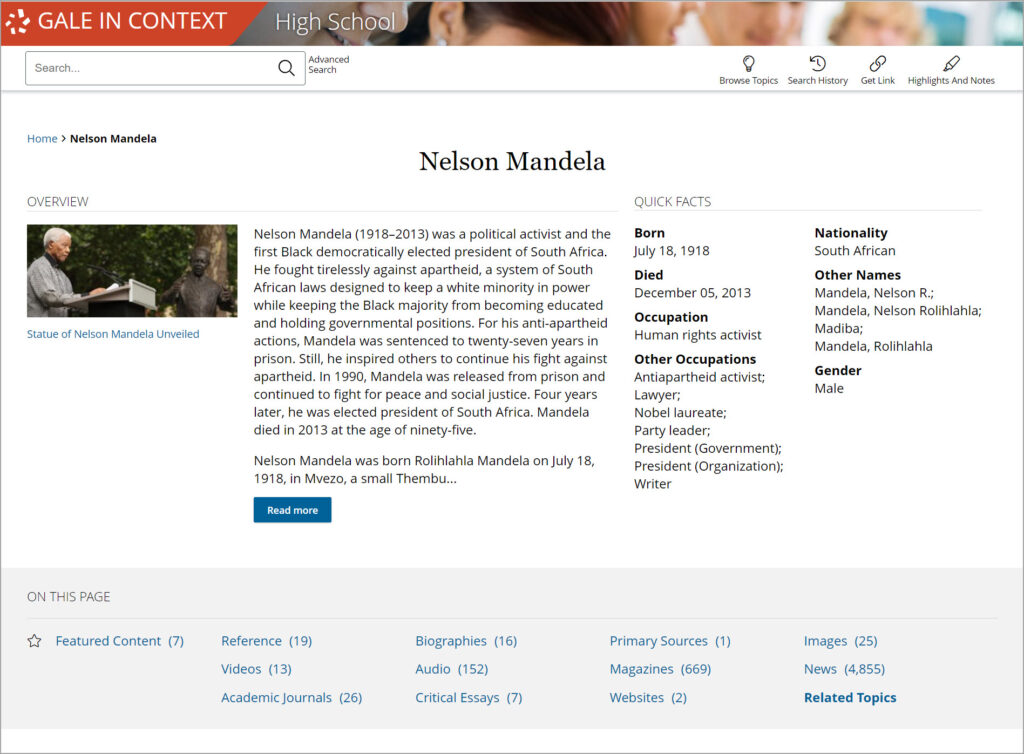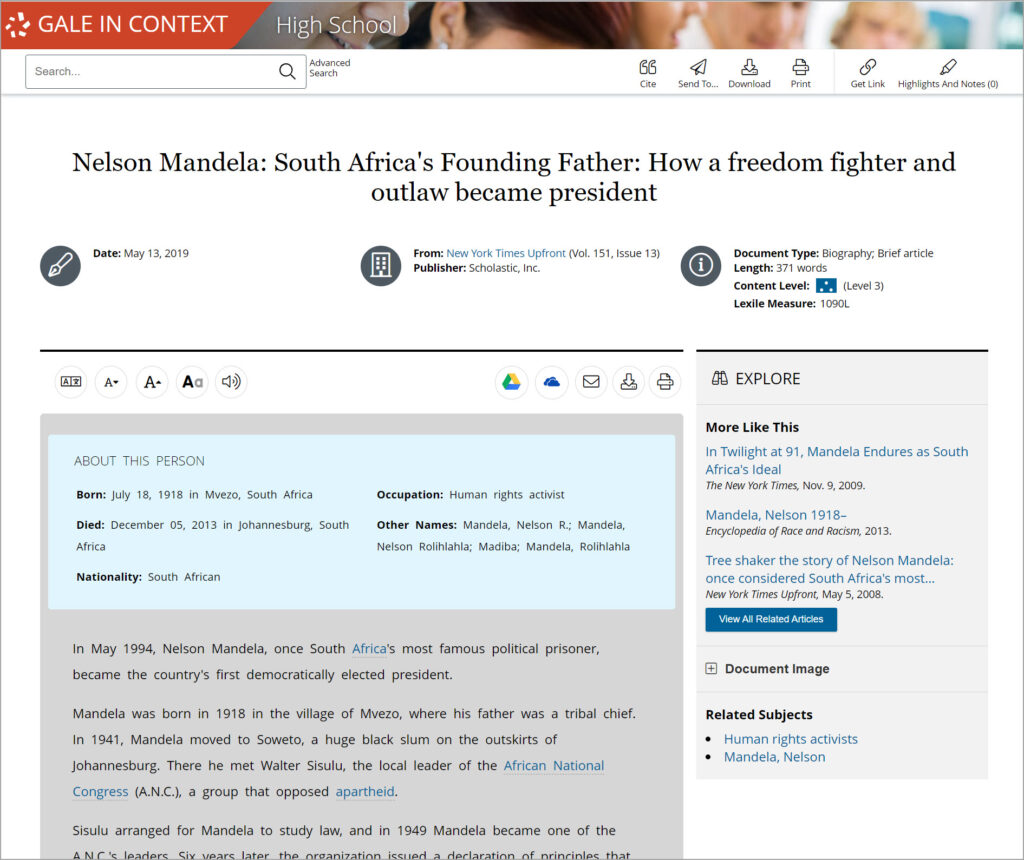| By Gale Staff |
Nelson Mandela’s accolades are many—he was South Africa’s first Black president, he is a Nobel Peace Prize recipient, and he is a beacon for civil rights around the world. For these reasons and more, the United Nations General Assembly declared July 18 as Nelson Mandela International Day, an annual observation that aspires to recognize Mandela’s lasting contributions to human rights and peace.
Mandela’s story is powerful and fraught with lessons that deftly apply to social and racial conflicts in the modern day. As we approach the end of the school year and Mandela’s official holiday, high school educators might wish to incorporate the history of his life into their lesson plans. Discussing his experiences, struggles, and many accomplishments can encourage rich conversations in your classes.
Using Gale In Context: High School, your students can independently learn about Mandela’s life and achievements. Gale’s built-in related articles help guide students in the research direction that piques their curiosity. After all, Mandela’s legacy touches on everything from women’s rights to environmental education, AIDS research, and racial equality. Bring students together to share what they’ve discovered—what surprised them and what inspired them?

Dig Into Nelson Mandela’s Biography
Gale In Context: High School has well-organized biographical summaries for the world’s major figures. Encourage your class to begin their research with Gale’s approachable Nelson Mandela outline. Born in South Africa in 1918, Mandela’s birth name was actually Rolihlahla, meaning “troublemaker.” At that time, it was common for South African schools to assign English first names to their pupils, and it was there that Rolihlahla was instead christened Nelson. His teachers’ lack of effort to learn his birth name is just one of the injustices that Black people faced in South Africa in the early 20th century.
Despite this, Mandela was a committed student and natural leader. He attended university and earned a law degree, and he used his education to help support the growing South African movement to dismantle apartheid. He was also a member of the African National Congress (ANC), a political party that sought equality for all South African citizens. Its members employed nonviolent tactics to help build support for their cause, and Mandela rose to power within the party.
Discussion Idea: After reading Mandela’s biography and learning about apartheid, ask your students to compare South Africa’s conflict with the Jim Crow period and the civil rights movement in the United States.
Examine Nelson Mandela’s Legacy
The South African government targeted Mandela, and in 1964, he was sentenced to life in prison for his role in the ANC. He spent nearly 20 years in a small prison cell, and he was not afforded comforts like bedding or plumbing. As a prisoner, he was starved and forced to work manual labor. Despite these harsh conditions, Mandela continued to pursue education and advocate for peace through nonviolent means.
Eventually, Mandela’s unjust imprisonment caught the attention of the international community, and the South African government offered him a release deal for his silence. He refused, and it was not until 1990 that the country finally freed him from prison. Following his release, Mandela rejoined the ANC’s cause and helped end apartheid in South Africa. In 1994, the country held free elections for the first time, and Mandela became South Africa’s first Black president. With his new global platform, he helped advance civil rights causes and developed social programs for those in need. He retired from the presidency in 1999 after just one term but continues to serve as an icon for peace and equality even after his death in 2013.
Discussion Idea: What are some of the tenets of Mandela’s legacy? Encourage students to share what lessons might still resonate today.
Consider His Story in a Modern Context
After learning more about Mandela’s life and legacy, help your high schoolers ignite their critical thinking skills. Gale’s biographies embed targeted critical thinking questions throughout each article, driving readers to think deeper about the material and apply their own perspectives. In some ways, South Africa’s history is not unlike the racial equity struggles of the United States. Today, despite both countries having had Black leaders and powerful civil rights movements, inequality, and racial violence persist.
Gale In Context: High School features current news articles from vetted, respected sources. Take a look at the stories published about Mandela in just the past few years, from new exposes to the commodification of his work. What legal questions and controversies linger in South Africa? How has the African continent changed in Mandela’s wake?

Discussion Idea: Have students find and read a more recent article about Mandela. How has the narrative changed over time, and in what ways are people continuing to carry his message?
Leverage Educator Resources
The history of Mandela’s life and civil rights are deeply important but complicated subjects. To help support educators in these teachings, Gale has curated material including thought-provoking questions and related articles. Now, there’s a whole suite of educator-focused resources teachers can access through the Gale In Context: For Educators database.
Gale In Context: For Educators is a comprehensive collection of professional development tools and activity ideas for teachers. As an instructional resource, For Educators fits seamlessly into existing workflows and offers educational resources for teachers as well as tools to support differentiated learning and cross-curricular efforts. With over 1,000 pre-built lesson plans, 2-5 formative assessment questions, and more than 115 topics to support DEI—For Educators makes success in every classroom easy!
As the school year comes to a close, prepare to celebrate Nelson Mandela International Day with Gale In Context: High School. And, to help make your job a little easier, take advantage of the supplemental teaching resources housed in Gale In Context: For Educators.

